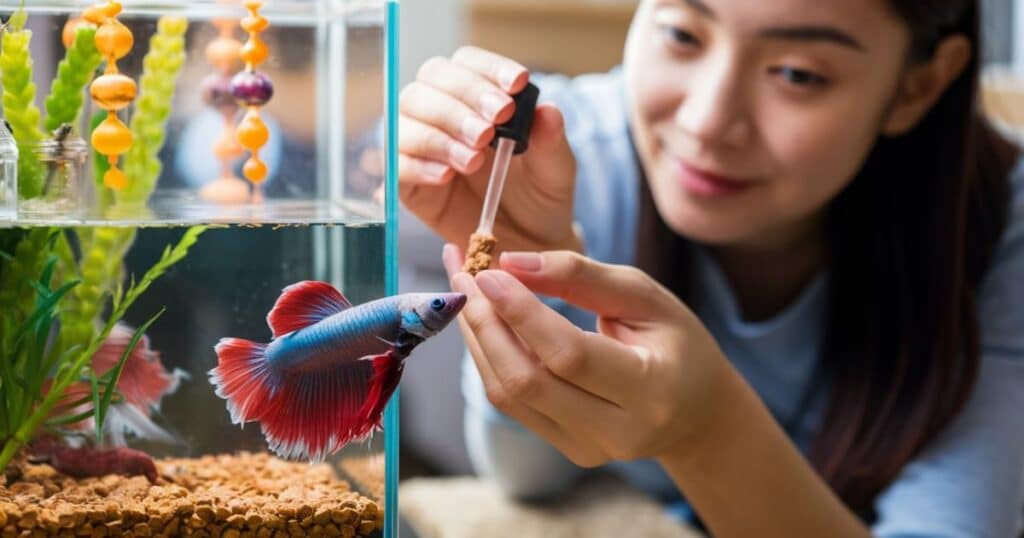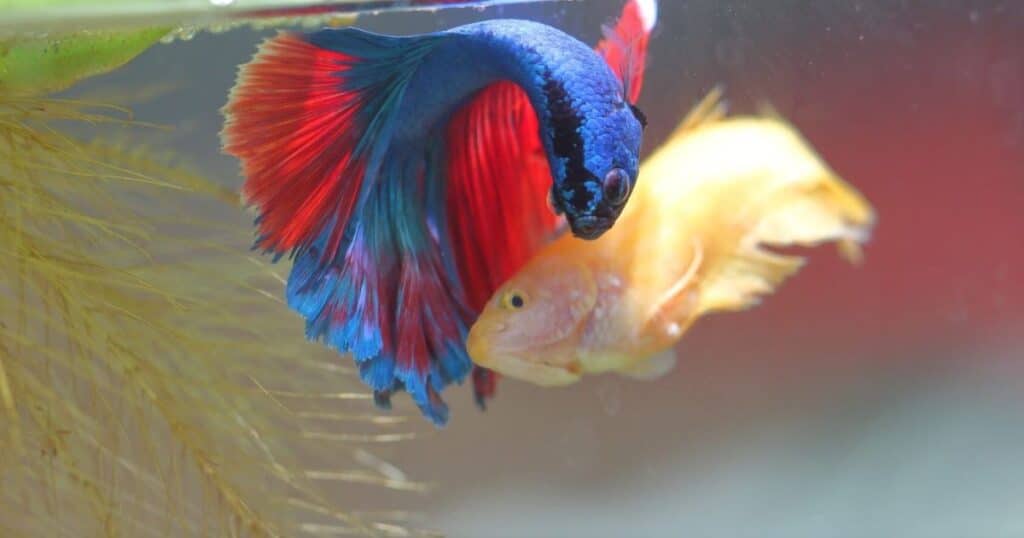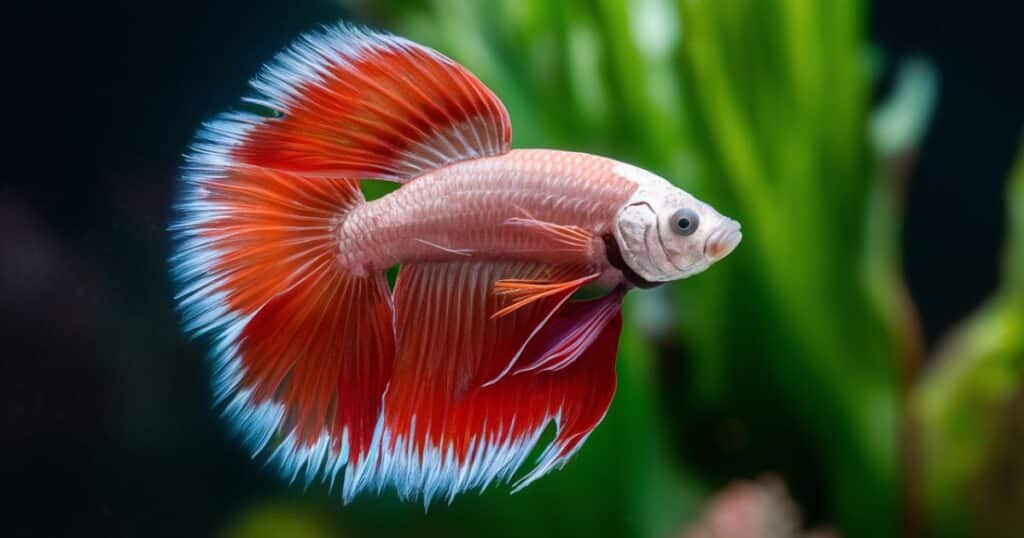In the vibrant world of aquarium enthusiasts, betta fish have long held a special place. Known for their striking colors and flowing fins, these fish have captured the hearts of many. But while male bettas often steal the spotlight, their female counterparts have remained in the shadows – until now.
Let’s dive into the fascinating world of female betta fish and discover why these aquatic gems deserve just as much attention and admiration.
The Fascinating World of Female Betta Fish
Female betta fish, scientifically known as Betta splendens, are a sight to behold. While they may not boast the long, flowing fins of their male counterparts, they possess a unique charm that’s all their own.
Physical Characteristics
Female bettas typically have shorter fins and a more streamlined body shape compared to males. This sleek physique allows them to be incredibly agile swimmers. Their colors can range from vibrant hues to more subdued tones, often with a pearlescent sheen that catches the light beautifully.
Key physical traits of female bettas:
- Smaller, rounder bodies
- Shorter fins
- Visible egg spot (ovipositor) beneath the belly
- Generally smaller overall size (2-3 inches)
READ MORE POST: Aquarium Red Fish: Your Ultimate Guide To Vibrant Underwater Worlds
Behavioral Traits
Female bettas are often described as more laid-back than their male counterparts. They’re curious creatures, always eager to explore their surroundings. Unlike male bettas, who can be territorial, females are generally more peaceful and can often coexist with other fish species.
“Female bettas are like the zen masters of the aquarium world. They’ve got all the beauty without the attitude.” – Jane Aquaria, Betta Enthusiast
Lifespan and Growth
In optimal conditions, a female betta fish can live for 2-4 years, sometimes even longer with exceptional care. They reach maturity at around 3-5 months of age, growing rapidly in their first few months of life.
Debunking Myths: Female vs. Male Bettas

There are many misconceptions about female bettas. Let’s set the record straight on some common myths:
| Myth | Reality |
| Female bettas are dull-colored | Many female bettas have vibrant, beautiful colors |
| Female bettas are less aggressive | While generally more peaceful, females can still be territorial |
| Female bettas are boring | Females are active, curious, and full of personality |
Color and Fin Differences
While male bettas are known for their long, flowing fins, female bettas have their own unique beauty. Their fins are typically shorter and more compact, which allows for greater agility in the water. As for colors, female bettas can be just as vibrant as males, with hues ranging from deep blues and reds to striking yellows and greens.
Aggression Levels
It’s true that female bettas are generally less aggressive than males. However, this doesn’t mean they’re completely docile. Female bettas can still display territorial behavior, especially when kept with other bettas or in a small tank. The key is to provide them with adequate space and suitable tank mates.
Tank Compatibility
One advantage female bettas have over males is their potential for community living. While male bettas often need to be kept alone, females can sometimes be housed with other fish species or even in groups of their own kind (known as a sorority tank).
Setting Up the Perfect Home for Your Female Betta
Creating the ideal environment for your female betta is crucial for her health and happiness. Let’s break down the essentials:
Tank Size and Requirements
While bettas can survive in small spaces, they thrive in larger tanks. For a single female betta, a minimum of 5 gallons is recommended. If you’re planning a sorority tank or community setup, you’ll need at least 20 gallons.
Tank setup checklist:
- 5+ gallon tank
- Secure lid (bettas can jump!)
- Heater
- Filter
- Thermometer
- Decorations and hiding spots
- Live or silk plants
Water Parameters and Temperature
Female bettas are tropical fish and require warm, clean water to thrive. Here are the ideal parameters:
- Temperature: 78-80°F (25.5-26.7°C)
- pH: 6.5-7.5
- Ammonia: 0 ppm
- Nitrite: 0 ppm
- Nitrate: <20 ppm
Filtration and Lighting Needs
A gentle filter is essential for maintaining water quality. Bettas prefer low water flow, so adjustable filters or sponge filters work well. For lighting, aim for 8-10 hours of moderate light daily. This mimics their natural habitat and supports plant growth if you have live plants.
Decorations and Plants
Female bettas love to explore their environment. Provide plenty of hiding spots with caves, driftwood, and plants. Live plants like Java fern, Anubias, and Amazon sword are excellent choices. They help maintain water quality and provide a natural feel to the tank.
Feeding Your Female Betta Fish

A balanced diet is key to keeping your female betta healthy and vibrant. Let’s explore their dietary needs:
Natural Diet in the Wild
In their natural habitat, bettas are insectivores. They primarily feed on mosquito larvae, small insects, and zooplankton. This diet is high in protein, which is essential for their health and coloration.
Best Commercial Foods
In captivity, a variety of high-quality commercial foods can mimic their natural diet:
- Betta-specific pellets
- Freeze-dried bloodworms
- Brine shrimp
- Daphnia
Homemade Food Options
For the adventurous aquarist, preparing homemade betta food can be rewarding. Here’s a simple recipe:
Homemade Betta Gel Food
- 1 pack unflavored gelatin
- 1 can of salmon or tuna (in water)
- 1 clove of garlic
- 1 cup of spinach
Blend all ingredients, heat until the gelatin dissolves, then pour into ice cube trays and freeze. Thaw small portions as needed.
Feeding Schedule and Amounts
Feed your female betta small amounts 2-3 times daily. A good rule of thumb is to offer only what she can consume in about 2 minutes per feeding. Overfeeding can lead to bloat and other health issues, so it’s better to underfeed slightly than to overfeed.
Health and Well-being
Keeping your female betta healthy involves more than just proper feeding. Regular observation and preventive care are crucial.
Common Health Issues in Female Bettas
Some health issues to watch out for include:
- Fin rot
- Ich (white spot disease)
- Swim bladder disorder
- Dropsy
Prevention and Early Detection
The best way to prevent illness is to maintain excellent water quality through regular water changes and proper filtration. Observe your betta daily for any changes in behavior, appetite, or appearance.
Basic First Aid for Betta Fish
If you notice any health issues, early intervention is key. Here are some basic first aid steps:
- Isolate the sick fish in a hospital tank
- Adjust water parameters if necessary
- Use appropriate medication (consult a fish veterinarian if unsure)
- Perform frequent water changes
The Social Life of Female Bettas
Unlike their solitary male counterparts, female bettas can be quite social under the right circumstances.
Can They Live with Other Fish?
Yes, female bettas can often coexist peacefully with other fish species. However, careful selection of tank mates is crucial. Avoid fin-nipping species or those that might outcompete the betta for food.
Good tank mates for female bettas:
- Neon tetras
- Corydoras catfish
- Harlequin rasboras
- Kuhli loaches
Creating a Female Betta Sorority Tank
A betta sorority tank houses multiple female bettas together. This can be a beautiful and dynamic setup, but it requires careful planning and monitoring.
Sorority tank tips:
- Use a 20+ gallon tank
- Include at least 5 females to distribute aggression
- Provide plenty of hiding spots and visual barriers
- Introduce all females at the same time
- Monitor closely for the first few weeks
Best Tankmates for Female Bettas
When choosing tankmates for your female betta, consider fish that occupy different areas of the tank and have similar temperaments.
| Fish Species | Compatibility | Notes |
| Neon Tetras | High | Peaceful schooling fish |
| Corydoras Catfish | High | Bottom-dwellers, help clean the tank |
| Harlequin Rasboras | High | Similar size, peaceful nature |
| Guppies | Medium | Caution: may nip fins |
| Angelfish | Low | Too large and aggressive |
Breeding Female Betta Fish

Breeding bettas can be a rewarding experience, but it requires careful preparation and dedication.
Selecting Breeding Pairs
Choose healthy, mature bettas with good fin and body shape. The female should be slightly smaller than the male and show vertical stripes when ready to breed.
Setting Up a Breeding Tank
A breeding tank should be around 10 gallons, with shallow water (about 6 inches deep). Include plenty of hiding spots and floating plants for the bubble nest.
The Spawning Process
- Introduce the female in a clear container within the breeding tank
- Allow the male to build a bubble nest
- Release the female when both fish show interest
- Monitor the spawning process closely
- Remove the female after spawning to prevent aggression
Caring for Fry
Betta fry are tiny and require special care:
- Feed infusoria or liquid fry food for the first week
- Gradually introduce baby brine shrimp and finely ground flakes
- Perform frequent small water changes
- Separate fry as they grow to prevent aggression
Entertaining Your Female Betta
Keeping your female betta mentally stimulated is important for her well-being.
Training and Tricks
Believe it or not, bettas can learn simple tricks! Try teaching your betta to:
- Swim through hoops
- Follow your finger
- Jump for food
Enrichment Activities
Provide various enrichment activities to keep your betta engaged:
- Rearrange tank decorations periodically
- Offer different types of food
- Use a feeding ring to create a “hunting” experience
Interactive Toys and Games
There are several betta-safe toys available:
- Floating logs
- Leaf hammocks
- Ping pong balls (for surface play)
Photographing Your Female Betta
Capturing the beauty of your female betta can be a fun and rewarding hobby.
Best Practices for Capturing Their Beauty
- Use natural light when possible
- Shoot from various angles
- Be patient and take lots of shots
Lighting and Equipment Tips
- Use a macro lens for close-up details
- Avoid using flash, which can stress the fish
- Consider a clip-on LED light for consistent lighting
Showcasing Your Betta on Social Media
Share your betta’s beauty with the world! Use hashtags like #femalebetta, #bettafish, and #aquariumhobby to connect with other enthusiasts.
Conclusion
In conclusion, Female betta fish are truly the unsung heroines of the aquarium world. With their vibrant personalities, stunning colors, and potential for community living, they offer a unique and rewarding experience for any fish keeper. Whether you’re a seasoned aquarist or a beginner, consider adding a female betta to your aquatic family. You’ll be amazed at the joy and beauty these little fish can bring to your life.
ALSO READ THIS POST: The Ultimate Guide To Fish Lice Treatment: Saving Your Finned Friends From Tiny Terrors
FAQs About Female Betta Fish
How long do female betta fish live?
Female bettas typically live 2-4 years with proper care.
Can female bettas change color?
Yes, female bettas can change color due to stress, age, or environmental factors.
Do female bettas make bubble nests?
While less common, some female bettas do make small bubble nests.
Are female bettas less aggressive than males?
Generally, yes, but they can still display territorial behavior.
Can I keep multiple female bettas together?
Yes, in a properly set up sorority tank of 20+ gallons with at least 5 females.

Davin Connor is an experienced author with 3 years in pets writing. Known for concise, informative content, he shares expertise on pet care, behavior, and health through his engaging articles.






